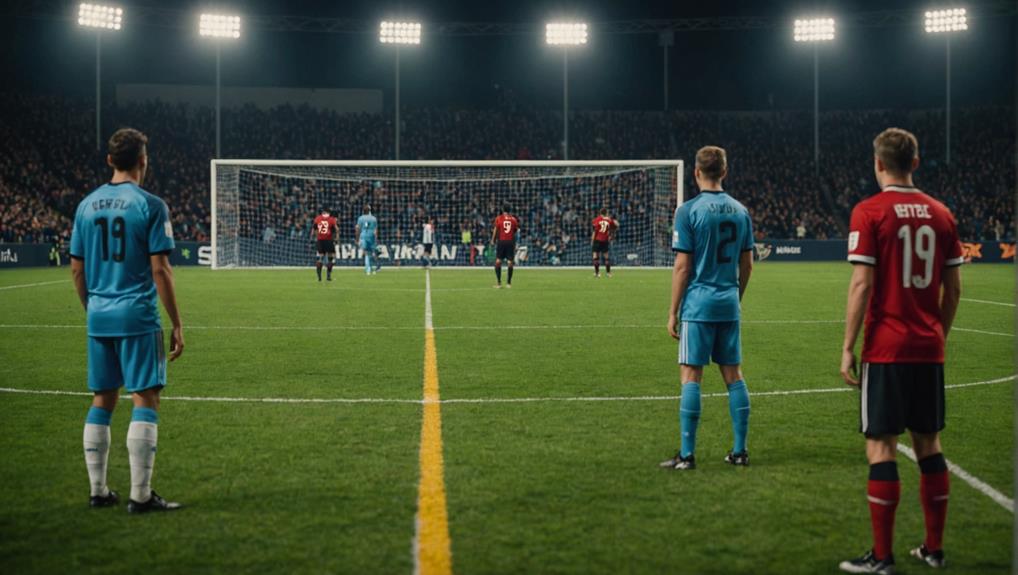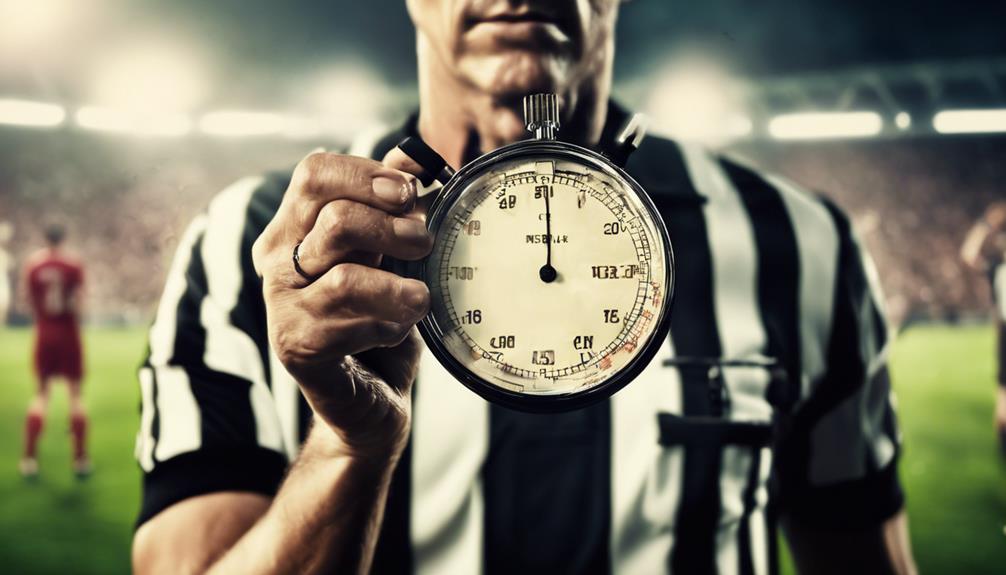
How Soccer Periods Work: An Overview
July 22, 2024Soccer matches have two 45-minute halves with continuous play. Stoppages occur for halftime, injuries, and substitutions. Extra time includes two 15-minute periods without breaks before a possible penalty shootout. Draws result in each team getting a point and can impact standing. In extra time, teams switch sides with no stoppage time. Penalty shootouts follow if the tie persists. Each team takes five kicks, and sudden death decides the winner if needed. Winning a shootout affects the match outcome greatly. The next part gives insight into the game's duration and stoppage time importance.
The Basic Structure
To understand the foundational elements of soccer periods, recognize that a match is divided into two halves, each lasting 45 minutes. During these halves, the clock runs continuously, with stoppages only for halftime, injuries, substitutions, and noteworthy delays like goals.
However, if the game is deadlocked after the standard 90 minutes, extra time comes into play. Extra time consists of two 15-minute periods without a break, providing teams with an opportunity to break the tie before resorting to a penalty shootout if needed.
Extra time introduces a new level of intensity and pressure to the match, as teams aim to secure a victory within the additional period. It requires players to dig deep, both physically and mentally, to push through the fatigue and maintain focus.
Understanding the possibility of extra time is essential for all involved in the game, as it can greatly impact the outcome and add an extra layer of excitement to the match.
Duration of Each Half
The duration of each half in a standard soccer game is pivotal in shaping the flow and outcome of the match. Understanding how much time is allocated to each half can influence strategies and player stamina throughout the game.
Here are some key points regarding the time structure of soccer halves:
- 45-Minute Halves: In a typical soccer game, each half lasts for 45 minutes, adding up to a total playtime of 90 minutes.
- Continuous Clock: The game clock in soccer runs continuously, pausing only for injuries, substitutions, or other significant stoppages.
- Halftime Break: Halftime in soccer gives players a 15-minute break to recover, rehydrate, and discuss tactics with coaches before resuming play.
- Game Length Impact: The duration of each half is essential in determining the overall length of the game and can influence player fatigue and game outcomes.
Understanding the time allocation in soccer matches is crucial for players, coaches, and fans to grasp the structure and intensity of the game.
Stoppage Time Calculation

Stoppage time in soccer is an essential component that adds extra minutes to each half to account for time lost during the game due to various factors. This additional time is determined by the referee and can vary based on events such as substitutions, injuries, time-wasting, and celebrations that disrupt the flow of the match.
Referees hold the sole authority to decide the amount of stoppage time needed to make up for the lost time fairly. The calculation of stoppage time is critical in maintaining the integrity of the game by ensuring that all interruptions are appropriately considered.
The referee's judgment on stoppage time can have a significant impact on the outcome of the game, as it provides teams with additional playing time that could potentially affect the final result. Understanding how stoppage time is calculated is essential for players, coaches, and fans to comprehend the full duration and dynamics of a soccer match.
Points Distribution for Draws
When teams draw in a soccer match, they each gain a single point in the standings. This approach guarantees that both sides are acknowledged for their performance, even without a clear winner.
Draws play a vital role in determining a team's overall position in the league table.
Draw Point System
Encouraging competitiveness, draws in soccer matches typically award each team one point in the standings.
Here are some key points regarding the draw point system:
- Incentive to Play for a Win: Knowing that a draw only yields one point, teams are motivated to go for the win rather than settling for a tie.
- Significant Impact on Standings: Points accumulated from draws play a significant role in determining a team's position in the league table and their chances of qualifying for playoffs.
- Equal Reward: Both teams are recognized for their performance in a draw, ensuring fairness in the distribution of points.
- Potential for Tiebreakers: In situations where teams end the season with equal points, the draw point system can set the stage for tiebreaker rules, which may involve criteria like goal difference or even a penalty kick shootout.
Tiebreaker Rules
Understanding tiebreaker rules in soccer leagues adds depth to following the sport and enhances your appreciation for the strategic aspects of the game. In soccer, tiebreaker rules come into play when teams have an equal number of points in the standings. While a draw typically awards each team one point, tiebreakers are vital for determining playoff qualification and seeding.
Leagues like the MLS use a points system where wins, draws, and losses impact a team's position. Teams aim to secure wins to maximize points and minimize the need for tiebreaker scenarios. Common tiebreakers in soccer include goal difference, goals scored, head-to-head results, and even disciplinary points.
Extra Time Overview

During extra time in soccer, two periods of 15 minutes each are played after the standard 90-minute game to break a tie.
Here's what you need to know about extra time:
- No Stoppage Time: Unlike the regulation 90 minutes, there's no added stoppage time during extra time. The clock runs continuously for each 15-minute period.
- Halftime Switch: After the first 15-minute period of extra time, teams switch sides before the start of the second period. This change helps guarantee fairness due to potential weather or pitch conditions.
- Tiebreaker Purpose: Extra time is specifically used in knockout matches or finals where a winner must be determined. It provides an opportunity for teams to resolve a deadlock before resorting to a penalty shootout.
- Penalty Shootout: If the score remains level after both 15-minute extra time periods, the game progresses to a penalty shootout. This thrilling tiebreaker can decide the winner of the match, making it a tense and exciting conclusion to the game.
Length of Extra Time
The length of extra time in soccer is set at two periods of 15 minutes each. These two periods are vital in determining the outcome of a match that remains tied after the regular 90 minutes of play.
Unlike regular play, there's no stoppage time during these additional periods; the clock runs continuously for a total of 30 minutes. The aim of these two periods is to break the deadlock between the teams before resorting to a penalty shootout.
It's a test of endurance, skill, and strategy as both teams battle it out for the coveted victory. Teams often approach these two periods with heightened intensity, knowing that every minute counts in their quest to secure a win.
If, at the end of these two periods, the score remains tied, the game proceeds to a penalty shootout to determine the ultimate winner.
Penalty Shootout Rules

Let's kick off by outlining the basics of penalty kicks during a shootout. Understanding the procedure is essential for grasping the dynamics of this intense game-deciding moment.
The ultimate goal is to emerge victorious by scoring more goals than the opposing team within the designated number of kicks.
Penalty Kick Basics
To understand the basics of penalty kicks in soccer, start by recognizing that a penalty kick is awarded for fouls committed in the penalty area by the defending team.
Here are some key points to help you grasp the essence of penalty kicks:
- Location: The penalty kick is taken from the penalty spot, which is situated 12 yards away from the goal line.
- Player Positioning: During a penalty kick, all players except the kicker and goalkeeper must be outside the penalty area.
- Goalkeeper Movement: The goalkeeper can move side to side on the goal line but mustn't advance forward until the ball is kicked.
- Outcome Determination: The team with the most goals after a series of penalty kicks wins the match if a result is needed.
Understanding these fundamental aspects of penalty kicks can enhance your appreciation of this important and often tension-filled aspect of soccer matches.
Shootout Procedure Explained
To explore the penalty shootout rules, which follow the principles of penalty kicks, you must understand the structured procedure employed to determine a winner in soccer matches.
In a penalty shootout, each team takes five penalty kicks, with players alternating shots from the penalty spot against the opposing goalkeeper. The team that scores the most goals after these initial five kicks is declared the winner of the shootout.
However, if the score remains tied after these initial kicks, the shootout enters sudden death. During sudden death, each team takes one kick at a time, and the first team to score while the other misses is declared the winner. This process continues until a decisive outcome is reached.
Penalty shootouts bring excitement and tension to soccer matches, as the fate of the teams hangs on the precision and nerve of the players taking the critical spot-kicks.
Winning the Shootout
In a penalty shootout, the team that scores the most goals after the initial five kicks is declared the winner. It's a tense moment that can decide the fate of the game in a matter of minutes.
Here's what you need to know about winning a shootout:
- Five Kicks: Each team gets five penalty kicks to show their accuracy and composure under pressure.
- Most Goals Win: The team with the highest number of goals after these five kicks emerges victorious from the shootout.
- Sudden Death: If the shootout is still tied after the initial five kicks, it progresses to sudden death, where teams take one kick each until a winner is determined.
- Game Outcome: Winning a shootout is vital as it directly impacts the final result of the match, making it a thrilling and nerve-wracking part of soccer games.
Understanding Soccer Periods
Gain a clear understanding of soccer periods by recognizing the structure of game time and the additional periods that may follow in case of a tie.
Soccer matches consist of two halves, each lasting 45 minutes, adding up to a total game time of 90 minutes. The clock runs continuously, with the referee including stoppage time for delays during play.
If a game is tied after the standard 90 minutes, some leagues implement extra time, comprising two 15-minute periods, to determine a winner. It's important to note that if a victor is still undecided following extra time, the match may progress to a penalty shootout to establish the outcome.
Grasping the timing of soccer periods is essential for players, coaches, and fans to comprehend the rhythm and potential results of a game. By understanding the structure of soccer periods, you can appreciate the strategic decisions made by teams during different phases of the match.
Conclusion
So there you have it, now you know how soccer periods work!
Did you know that the average stoppage time in a soccer match is around 4-6 minutes per half?
It's amazing how those few extra minutes can make all the difference in a game.
Keep watching and playing soccer to see these periods in action!


